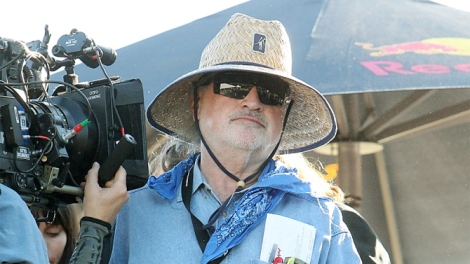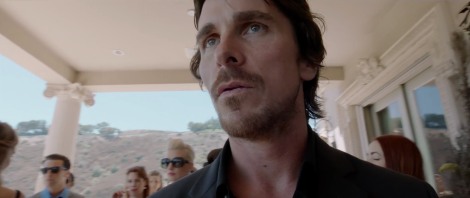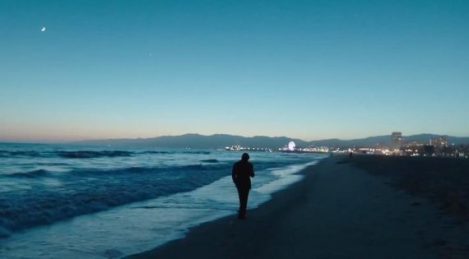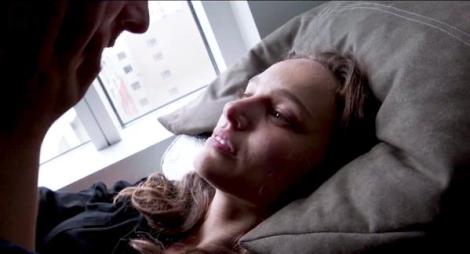 No, these are not the opening words of the brilliant, elusive Terrence Malick’s latest cinematic tone poem, but the prologue to the lead single on Kanye West’s multifarious record, The Life of Pablo. And yes, that’s how we’re going to kick off this essay.
No, these are not the opening words of the brilliant, elusive Terrence Malick’s latest cinematic tone poem, but the prologue to the lead single on Kanye West’s multifarious record, The Life of Pablo. And yes, that’s how we’re going to kick off this essay.
It’s not a stretch that a track titled “No More Parties in L.A.” could draw parallels to Malick’s loose narrative about an L.A.-based screenwriter drowned in empty Hollywood excess, yet anyone would probably say I’d be a bit far reaching to make a pointed comparison between Yeezy and Terry as artists. Similarities between the content of The Life of Pablo and Knight of Pablo are somewhat obvious when submitting yourself to their alluring (and frustrating) spell, both addressing what it feels like to be an artist addicted to experience, change, romantic entanglements, and daily excitements, with an environment that enables this addiction instead of promoting love of life as a flawed, imperfect whole.
But I feel as though the Yeezy-Terry cross-medium parallel is deeper and more significant than the similarities between these two works. (And after I guess this out of the way, I promise I’ll talk about the movie you came here to read about). So here it goes…
Kanye’s art relies on a persona that showcases his responses to a frenzied, decisively insane celebrity-based culture, and it’s no accident that his reaction to public occurrences in life and art are typically arrogant, self-obsessed, messy, and seemingly not well thought through. He creates great content, by submerging himself SO deeply in this culture, that his creativity and ingenuity when addressing matters of this lifestyle are uniquely brilliant. They come from the inside out.
 As listeners, we can’t get enough, even when the content addresses this toxic culture that Kanye feeds into, one that we tell ourselves we despise. And we also can’t help but slam Yeezy as a person because, objectively, he seems like a huge prick. Still, the music’s gotta come from somewhere. And as outsiders to this world of Kanye’s, listening in, we permit ourselves to be fascinated because it’s music, not the stuff of “real life” depicted on our Twitter feeds.
As listeners, we can’t get enough, even when the content addresses this toxic culture that Kanye feeds into, one that we tell ourselves we despise. And we also can’t help but slam Yeezy as a person because, objectively, he seems like a huge prick. Still, the music’s gotta come from somewhere. And as outsiders to this world of Kanye’s, listening in, we permit ourselves to be fascinated because it’s music, not the stuff of “real life” depicted on our Twitter feeds.
I’m not saying Kanye’s submission to the over-the-top, publicly (and often digitally) depicted lifestyle is some kind of artistic martyrdom, but it’s undeniable that there’s a rare, unique sort of ambition here, which is evident in the manner that with each release, he essentially reinvents the hip-hop album. The process, controversy, and unveiling of his music is as interesting as the work itself.
Terrence Malick doesn’t exactly reinvent film with each release. Simultaneously more impenetrable, impressionistic, and experimental than any of his prior films (if you found The Tree of Life pretentious or even struggled to sit through it, you best sit this one out), Knight of Cups still has all the common elements of his recent moviemaking – philosophical voiceover and verbal reflections (often fading in and out over classical compositions), gorgeous cutaways to natural landscapes and the cosmos, extraordinary usage of natural light and roving cinematography from (now three-time Oscar winner!!) Emmanuel Lubezki, and an approach to narrative that finds a spiritual dimension through juxtaposition of human performance and emotion with color, shape, pattern, and sound.
One of Malick’s most clear influences is the great Andrei Tarkovsky, the undisputed king (IMHO) of visual storytelling and spiritually transcendent filmmaking. Tarkovsky’s influence has recently made quite a resurgence, particularly clear in the success of Alejandro González Iñárritu’s The Revenant, also shot by Lubezki and featuring the work of Malick’s long-term production designer, Jack Fisk. Despite not reinventing the wheel, however, it’s clear that Malick’s work comes from a place unprecedented in contemporary cinema.
While Kanye envelopes himself in the culture that fuels his music, Malick stays as far away from Hollywood media culture as possible, and in the process, makes films that are as anti-Hollywood in form as they come. He doesn’t do interviews, he doesn’t show up at premieres, festival screenings, or awards shows, there are huge gaps in his biography that are completely missing, major stars somehow agree to be his films (which then somehow get funded), and only a handful of images of him seem to publicly exist. Quite the opposite of Yeezy, whose schtick is entirely reliant on remaining within the public eye.
 As a result, we think we have a pretty good idea exactly who Kanye West is. In fact, his work is dependent on it. I think it’s safe to say that if you haven’t worked together, or you’re not within his immediate circle of family or friends, you have no idea who the hell Terrence Malick is. How could you?
As a result, we think we have a pretty good idea exactly who Kanye West is. In fact, his work is dependent on it. I think it’s safe to say that if you haven’t worked together, or you’re not within his immediate circle of family or friends, you have no idea who the hell Terrence Malick is. How could you?
His films are all we have to understand Malick, and just as Kanye uses his public shenanigans and absurd, egotistical transparency to enhance the mystique of his music, Malick uses his unprecedented lack of media engagement and anonymous, shamen-like persona to enhance the mystique of his films. His work is dependent on you NOT knowing exactly who he is. And just like Yeezy, it totally works.
It’s no coincidence that Kanye West and Terrence Malick would end up creating projects that are very similar in content, nor that one of Malick’s films would end up featuring a surrogate protagonist who is as anonymous, distancing, and cryptic as Malick appears to us in real life. Unlike Kanye’s central Pablo figure in his most recent album, I doubt Malick relates to his character in Knight of Cups on the level of having directly experienced what it feels like to have an over-the-top, decadent lifestyle in Los Angeles. But then again, and I believe part of the point is, how would we really know? Does this character represent a fictional alternative to a path Malick could’ve taken in his career?
Both works follow their creators’ surrogate protagonist through something of an existential journey, although by this point, I feel it appropriate to shift gears toward the movie in the title of this piece (although I can’t help but wonder by this point – if Kanye saw this film, what would he Tweet about it?). Christian Bale plays Rick, the screenwriter in the title role of a film structured by tarot-cared themed chapters, each charting his engagement with a different individual, or set of individuals (mostly women).
To be frank, Bale looks pretty lost in this film, like he has no idea what he’s doing or why he’s there. We know this is pretty factual; I mean, the guy never even got a script. He stuck it out, of course, and I think it’s safe to say that anybody accepting a Malick role nowadays knows what they’re getting into (Bale even co-starred in Malick’s The New World back in 2005).
 His performance is hard to objectively rate because of this reason. Did he accidentally give a great one? Could he have performed better with more conventional direction? These questions turn out to be pretty meaningless when looking at the film as whole. The intention was to depict an artist who has become aimless, and the result is moderately successful. The execution of this goal is also incredibly bizarre.
His performance is hard to objectively rate because of this reason. Did he accidentally give a great one? Could he have performed better with more conventional direction? These questions turn out to be pretty meaningless when looking at the film as whole. The intention was to depict an artist who has become aimless, and the result is moderately successful. The execution of this goal is also incredibly bizarre.
Any synopsis you read of Knight of Cups refers to Bale’s character as a screenwriter, although we only get a sense of his exact profession in a few scenes. We really have no clue what his passions are, or what (if any) redeeming qualities he has – he does stick up for his father during a heated argument with his brother (the third brother/son has died, presumably of suicide, an alleged autobiographical element also featured in The Tree of Life), so I guess that counts. In fact, Rick barely utters a word. His entire constitution has become subdued.
Yet he is representative of the white, male success fantasy – rich, surrounded by beautiful women, and free to wander as he pleases. Few responsibilities, and even fewer obligations to address issues of “real” significance, in personal or professional life. Rick often shuts out his family and female companions emotionally, and seems to have almost entirely lost interest in his work. As one character states, “Drinking is bad, but feelings are worse.”
By definition, he is a creator, and has the privilege of using art to convey meaning. Yet at his current age, it seems as though the Knight is more interested in preserving youth than finding meaning. As a result of his presumed success, he has the means to distract himself from grief, regret, and the inevitable end by pursuing sporadic excitements and the company of new women. He’s not that interesting or friendly of a guy, but nobody seems to care. They still actively engage and share his company, because hey, just look at him!
Few moments ground Knight of Cups in any sort of naturalistic reality that breaks us from a dreamlike cascade of stream-of-consciousness images. The film is always moving, flowing like water, organically changing and reinventing itself as it goes along. It eventually becomes quite repetitive, because like its protagonist, it seems to be willingly shutting itself off from going anywhere. Yet this is one of the most admirable things about it. The Knight’s boredom, confusion, and aimlessness is reflected by an aesthetic that visualizes these feelings perfectly.
Terry cuts away to gorgeous shots of the L.A. cityscape, breathtaking desert imagery, or P.O.V. imagery of an expensive vehicle zooming down a Southern California freeway more times than you’ll believe. And all the while, it seems entirely justified within the story being told. He overdoes the Malickisms to signify a man’s state of mind, a rut of recycled sights and sounds, gorgeous yet under appreciated. And if Rick’s guilt is further amplified by feelings of not appreciating the beauty surrounding him, we feel equally dissonant about not enjoying these striking images when placed within such an onerous narrative.
 If Bale’s performance is an example of the film’s blurred line of fiction and nonfiction, equally so are its scenes of upper-tier Los Angeles party culture (I swear, I will sync up this movie with Pablo when it comes out on video). An early scene features a mansion party with random cameos that range from Jason Clarke to Nick Offerman, where we hear snippets of dialogue that are more funny, absurd, and satirical than anything else featured in a Malick film. (i.e. Mr. Offerman – “My life is like Call of Duty on easy mode, I just walk around and f**k s**t up!”)
If Bale’s performance is an example of the film’s blurred line of fiction and nonfiction, equally so are its scenes of upper-tier Los Angeles party culture (I swear, I will sync up this movie with Pablo when it comes out on video). An early scene features a mansion party with random cameos that range from Jason Clarke to Nick Offerman, where we hear snippets of dialogue that are more funny, absurd, and satirical than anything else featured in a Malick film. (i.e. Mr. Offerman – “My life is like Call of Duty on easy mode, I just walk around and f**k s**t up!”)
One gets the sense that Malick and Chivo (what Lubezki’s acquaintances call him) simply arrived with their camera and just shot, while the stars already planned being there anyway. I can easily envision Hollywood heavyweights exchanging the following – “Hey, are going to the boozefest on Tuesday afternoon? Heard Terrence Malick might show up and film it!” Meanwhile, Antonio Banderas takes the reins and serves as a Lynchian sort of guide to the chaos, which like most of the film, feels like a drug-induced out-of-body experience.
That concept is further enhanced by the sporadic use of GoPro footage (I’ll spare you the comparison to a GoPro-referencing lyric in Pablo track, “Highlights”), featuring cameras that Malick allegedly handed out to the cast so they could capture expressionistic footage of their own. Knight of Cups occasionally resembles if a millenial had rewritten Fellini’s 8 1/2 and somehow convinced Mr. Malick to direct it, which is especially evident in the episodic structure of how Rick’s relationships with women are depicted.
Revealing moments occur in the segment with Rick’s ex-wife, played by Cate Blanchett, and the sequence with Teresa Palmer’s stripper character features one of the most existential scenes I’ve ever seen in her place of business. Yet the most emotionally vivid and well-acted moment in the film is performed by Natalie Portman, in one of many latter scenes with Bale. Without giving away key “plot” information, the moment I’m referring to is one of the first that requires Rick to think outside himself, and truly empathize with another individual. It’s a short detour from being contained within his own mind and personal crises. The other comes during an earlier moment with Blanchett, as Rick ponders what it would’ve been like to have a child, and possibly relate to life outside of something of his own experience.

On terms that are unique to its personal vision, I’d argue that Knight of Cups is more critical of Hollywood via its experimental use of film craft than its predictably scathing story of a creative type who has been essentially stripped of his soul in the City of Angels. This a film made by a wise, aging artist, who has written a character who numbs himself, drinking a limbo-inducing elixir that allows him to forget his human inclination of pursuing meaning, purpose, and truth. Why does Rick do this? Likely because he fears there’ll be nothing there. Just the end of the road.
Yet slowly but surely, he begins to come around. He begins to see meaning as something that can’t be shaken, something that’ll always be there, despite the inevitability of death, if you simply muster the courage to look around you. To see.
Movies help us see, and they also have the capacity to tell the truth. Yet so many Hollywood pictures consist of pure lies, from protagonists who are false idealizations of ourselves to stories that neatly tie their occurrences into a three act structure. Life isn’t like that. It’s incomplete, moments weave in and out of one another, we’re never always sure of who we want to be or where we’re going, sometimes we’ll even reach a destination and wonder what our objective was in the first place. Grief, rage, love, loneliness, sex, and gifts of nature stream before our eyes and cannot be contained within the realm of simple explanation. But meaning can still be there. Beauty can still be there. It’s all in what the eye chooses to see. But Hollywood would rather tell you what to see, and as a response to this mass-produced agenda, I think Malick has created one of the most critical films of the system ever made.
Knight of Cups is ultimately a reflection of Terrence Malick’s fulfillment and self-satisfaction with his own artistic process, much as The Life of Pablo is Kanye’s. To tie up this similarity in a neater way than this essay deserves, consider that Pablo‘s release was delayed for one reason or another for over a year, while its title changed countless times. Knight of Cups was in post-production for roughly two years. But now they’re finally here, together, and despite not being their creators’ best work, find near-greatness in their sprawling, flawed, and remarkably ambitious packaging.
As Helen, a model played by Freida Pinto, states in Malick’s singular vision of Hollywood, “Dreams are nice, but you can’t live in them.” For the entire duration of Knight of Cups, Rick has been living within a dream. By film’s end, he has woken up. As we exit the theater, the dream ends for all of us, as outdoor light blinds us with possibilities of meaning, of purpose. Together, we begin.
